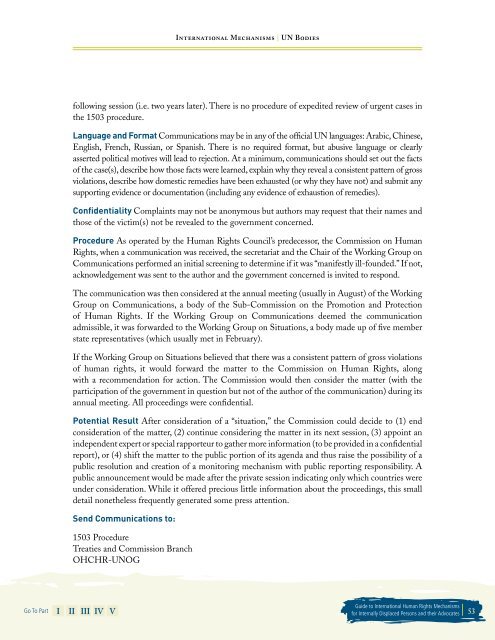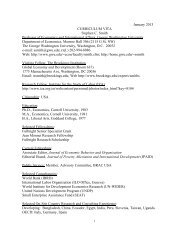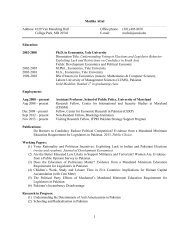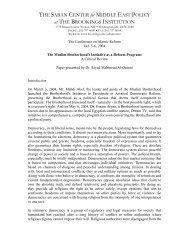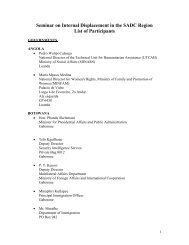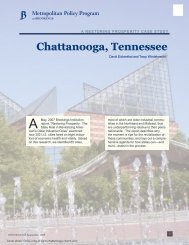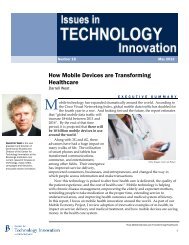Guide to International Human Rights Mechanisms - Brookings
Guide to International Human Rights Mechanisms - Brookings
Guide to International Human Rights Mechanisms - Brookings
You also want an ePaper? Increase the reach of your titles
YUMPU automatically turns print PDFs into web optimized ePapers that Google loves.
Go To Part I II III IV V<br />
<strong>International</strong> <strong>Mechanisms</strong> | UN Bodies<br />
following session (i.e. two years later). There is no procedure of expedited review of urgent cases in<br />
the 1503 procedure.<br />
language and format Communications may be in any of the official UN languages: Arabic, Chinese,<br />
English, French, Russian, or Spanish. There is no required format, but abusive language or clearly<br />
asserted political motives will lead <strong>to</strong> rejection. At a minimum, communications should set out the facts<br />
of the case(s), describe how those facts were learned, explain why they reveal a consistent pattern of gross<br />
violations, describe how domestic remedies have been exhausted (or why they have not) and submit any<br />
supporting evidence or documentation (including any evidence of exhaustion of remedies).<br />
confidentiality Complaints may not be anonymous but authors may request that their names and<br />
those of the victim(s) not be revealed <strong>to</strong> the government concerned.<br />
Procedure As operated by the <strong>Human</strong> <strong>Rights</strong> Council’s predecessor, the Commission on <strong>Human</strong><br />
<strong>Rights</strong>, when a communication was received, the secretariat and the Chair of the Working Group on<br />
Communications performed an initial screening <strong>to</strong> determine if it was “manifestly ill-founded.” If not,<br />
acknowledgement was sent <strong>to</strong> the author and the government concerned is invited <strong>to</strong> respond.<br />
The communication was then considered at the annual meeting (usually in August) of the Working<br />
Group on Communications, a body of the Sub-Commission on the Promotion and Protection<br />
of <strong>Human</strong> <strong>Rights</strong>. If the Working Group on Communications deemed the communication<br />
admissible, it was forwarded <strong>to</strong> the Working Group on Situations, a body made up of five member<br />
state representatives (which usually met in February).<br />
If the Working Group on Situations believed that there was a consistent pattern of gross violations<br />
of human rights, it would forward the matter <strong>to</strong> the Commission on <strong>Human</strong> <strong>Rights</strong>, along<br />
with a recommendation for action. The Commission would then consider the matter (with the<br />
participation of the government in question but not of the author of the communication) during its<br />
annual meeting. All proceedings were confidential.<br />
Potential result After consideration of a “situation,” the Commission could decide <strong>to</strong> (1) end<br />
consideration of the matter, (2) continue considering the matter in its next session, (3) appoint an<br />
independent expert or special rapporteur <strong>to</strong> gather more information (<strong>to</strong> be provided in a confidential<br />
report), or (4) shift the matter <strong>to</strong> the public portion of its agenda and thus raise the possibility of a<br />
public resolution and creation of a moni<strong>to</strong>ring mechanism with public reporting responsibility. A<br />
public announcement would be made after the private session indicating only which countries were<br />
under consideration. While it offered precious little information about the proceedings, this small<br />
detail nonetheless frequently generated some press attention.<br />
send communications <strong>to</strong>:<br />
1503 Procedure<br />
Treaties and Commission Branch<br />
OHCHR-UNOG<br />
<strong>Guide</strong> <strong>to</strong> <strong>International</strong> <strong>Human</strong> <strong>Rights</strong> <strong>Mechanisms</strong><br />
for Internally Displaced Persons and their Advocates


